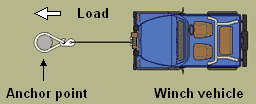 |
|
Winches are very powerful machines and are designed to move loads such as boats,
fallen trees and vehicles. They are an invaluable recovery tool as, when treated
knowledgably and with respect and caution, they allow
for efficient vehicle recovery.
|
 |
 |
 |
|
Winches are usually very slow and precise. When the end of the winch cable is securely
anchored, they operate by winding the winch cable onto a drum and thereby pulling the vehicle
or the load, depending on circumstance. The versatility of winches is further increased when
used in conjunction with pulley blocks, which can double a
winch's pulling power.
|
 |
| Important Safety Information |
 |
 |
|
ALWAYS USE EXTREME CAUTION AND STAND CLEAR when using winches. If the
winch cable breaks, the winch clutch becomes disengaged or towing fixtures
tear loose, the cable will snap and whip wildly. Never step over
a "live" winch cable (a winch cable bearing a load) and don't allow
anyone else to do so.
|
 |
|
NEVER ATTACH A WINCH CABLE TO A VEHICLE'S BUMBER. Bumpers are not designed
to withstand the stresses a winch produces. Use the vehicle's tow or recovery
points.
|
 |
|
ENSURE THERE ARE AT LEAST 5 COMPLETE TURNS OF WINCH CABLE REMAINING ON THE
DRUM. The rope fastener will not support a load with less than 5 turns still
on the winch drum.
|
 |
|
Always use shackles to hitch your winch cable. NEVER HOOK THE WINCH CABLE
BACK ONTO ITSELF. This creates unacceptable strain, breaking individual
strands which weakens the entire winch cable.
|
 |
|
LEARN TO USE YOUR WINCH. Take the time and practice using your winch
so you will be familiar with it when the need arises.
|
|
 |
| Guidelines for Safe Winch Operation |
 |
|
As with any vehicle recovery procedure, there are rules for the safe operation of
a winch that must be adhered to in order to minimize the risk of vehicle damage and
personal injury.
|
 |
 |
 |
|
As shown in the image above, opening the hood of the winching vehicle can minimize
risk of property damage and personal injury, should the winch cable snap and whip back under
load. Another recommendation is to lay a blanket over the winch cable. If
the winch cable were to snap, the blanket will dampen much of the energy of the
cable, and further reduce the risk of damage and injury.
|
 |
-
Inspect the winch cable and equipment frequently. The wire winch cable should
be inspected for damage that can reduce its breaking strength. A frayed cable
with broken strands must be replaced immediately. Note that any replacement
must be identical in strength, quality, lay and stranding.
-
Always use Gloves. Always wear gloves when handling or rewinding the
winch cable to eliminate the possibility of cuts or other injury caused by
burrs and slivers from broken strands!
-
Avoid continuous pulls from extreme angles. Winching from extreme angles
causes the winch cable to pile up at one side of the drum, causing the winch cable
to snag and "cut" into itself, flattening and breaking strands and further weakening
the winch cable. Always aim to get the winch cable as straight as possible from the
direction of the vehicle.
|